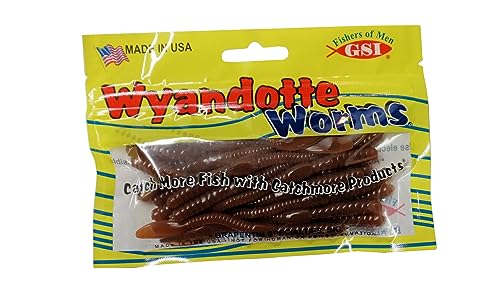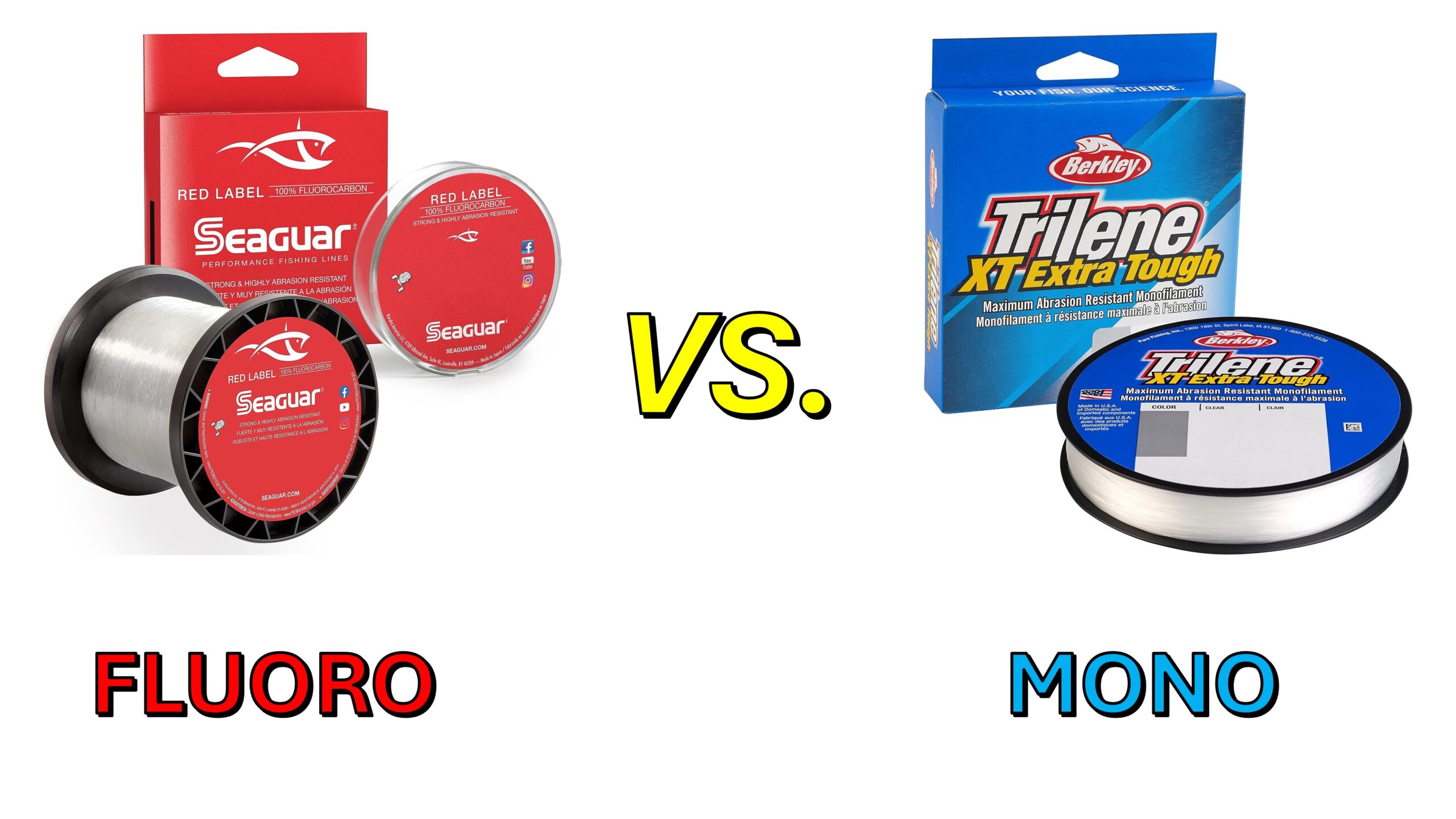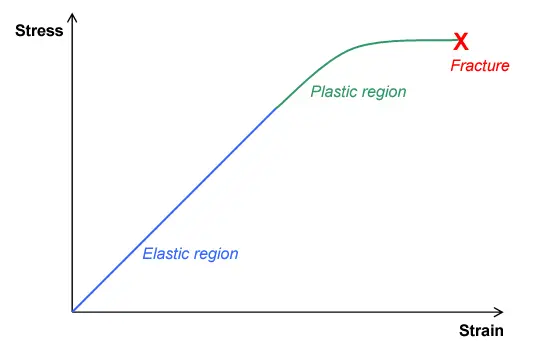The One Thing All of the Best Fishermen Do
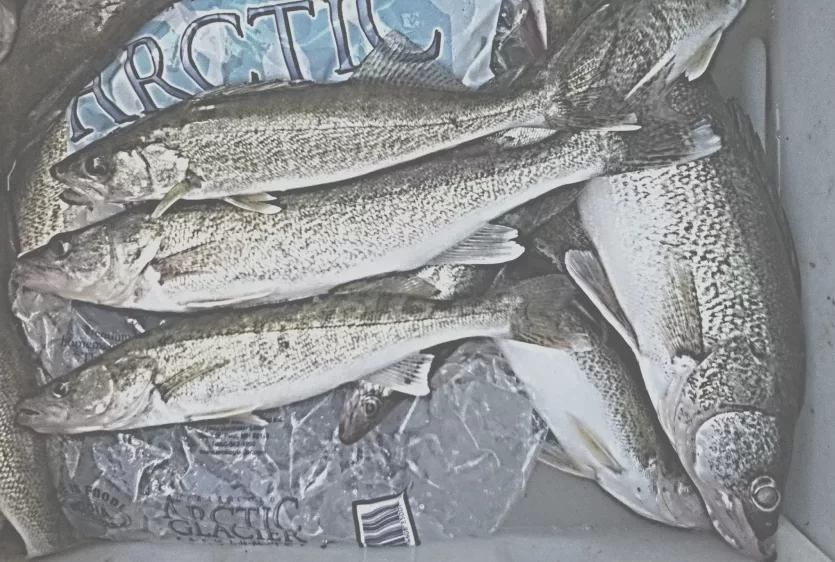
* This page contains affiliate links. The Great Lakes Fisherman may earn a commission on items purchased through these links. For more on this, please click here.
Did you ever wonder what separates the good fishermen from the really great fishermen? Is it the gear that they have? Is it their knowledge of a particular body of water? Maybe it’s just dumb luck? Well, I would be naive if I said that those had nothing to do with it. But there is one thing that separates good fishermen from the best. And it doesn’t involve any of those factors just mentioned. The best fishermen are willing to take the time and effort to make small changes to their techniques in order to marginally increase their catch rates.
Now, you might think that if it’s marginal then it’s not worth it. But as a rich man once said, the way you get rich isn’t by selling a single good or service for a large profit. The way you get rich is by selling a large number of goods or services for a small profit. Said a different way, these small improvements in technique add up and compound over time. This habit of continual, albeit small, improvements is a proven process in many aspects of life – and fishing is no exception.
Fishermen and Meteorologists
Another way to think about it is to consider weather forecasting. Being a great fisherman is a lot like being a great weather forecaster. A meteorologist can use science to predict the massive changes in weather patterns. But no matter how good their knowledge of the physics of weather is, there is no substitute for the volumes of real data that computer models collect and use to make strikingly accurate predictions.
And this translates to the fishing world. The only difference is that your brain is the computer and your personal knowledge from past fishing experiences is the data that forms the model. By paying attention to the smallest of changes every time you fish and adjusting accordingly, you will improve your results, just as a weather model improves its forecast.
The Twitch
The following is an example of one such small improvement which has greatly improved our catch rates for walleye.
When fishing a favorite walleye lake of ours in Canada, we like to troll in the last hour or so of daylight to catch walleye that are cruising the shallows for an evening meal. Trolling the original black & white Rapala is a proven technique on many of these lakes. The low-light contrast of the black top with the white underbelly of the lure sticks out like a sore thumb to walleye who can see much easier in these low-light conditions than many other fish (for more on this see Lure Color Selection).
The first time we took my dad with us on this trip we couldn’t help but notice that even though he was using the exact same lure we were using, he was outcatching us nearly 2:1. So I started paying attention to where and when he was catching the fish.
In the trolling route we were following, I wanted to see if he was catching his fish on the shore side or the deeper side. Maybe the fish were really hugging those reeds. But no pattern emerged that pointed to that. He seemed to catch as many fish on the reed side of the boat as he did on the open lake side.
I also paid attention to see if was catching more fish when the boat turned around. Maybe lure speed made a difference. Was the change in lure speed on the turns triggering the strike? Not that I could tell.
To this point, the things I was looking for were more circumstantial. After all, we were using the exact same lures and trolling them in the same areas and from the same boat. How could he be so much more successful than the rest of us?
But then I noticed a small movement out of the corner of my eye. His rod tip had moved slightly from a small twitch of the hand. I started to watch this rod. He would twitch the rod forward and then let the lure fall back, then twitch forward and let it fall back. The rythym of this was very similar to the rythym one might depart to a jig on the lake bottom. And before long, he had another fish on.
Needless to say, I tried it for myself and before long, I too, had my next fish. As I continued to make this subtle change to my technique, my catch rate instantly went up. From that point forward we incorporated that technique to our repertoire. It was a very minor adjustment, but it made a huge difference in our results.
Small Changes Over Time
This was just one example of a way to increase the odds of putting more fish in the boat. There are countless adjustments that can be made to improve the catch rate. Each improvement, however minor, pushes your success rate in a postive direction and often compounds the effects of other improvements you have already made. Much like money grows, so too will your catch rates. And this is what separates the really great fishermen from the rest of the pack.
Nobody wants to make fishing to seem like a job. Fishing is for enjoyment. For many, catch rates aren’t that important. In fact, some folks would find less enjoyment if they had to contuously look for improvements. And there is nothing wrong with that. We all find enjoyment in different ways.
But if you are the type of person who is looking to improve, don’t stop trying new things. Maybe a successful catch goes from a fish or two, to an occasional limit. Or from an occassional limit to limiting more often. Maybe you go from catching smaller fish to bigger fish. Whatever the case, improvement in fishing will come with time and effort like anything else, and it is often the small changes over time that make the biggest diffrence.
Spring Crappie

* This page contains affiliate links. The Great Lakes Fisherman may earn a commission on items purchased through these links. For more on this, please click here.
Crappie are a mysterious fish to many. In fact, I know some avid fishermen who have fished their whole lives but have rarely caught crappie. It may seem strange, but crappie are something you really need to target in order to catch many of them. For most of the year, anglers focus on other species and crappie are generally left alone. But spring crappie are relatively easy to catch as they hang out close to shore and become very aggressive.
Fishing for springtime crappies is a great way to introduce young anglers to the sport of fishing. The action can be fast. And the fish are big enough to be exciting, but not overwhelming for a 4 or 5 year old to handle.
When Do Crappie Spawn?
Crappie tend to begin staging off of their spawning grounds when water temps get into the low 50’s. Spawning usually begins when the temps reach the upper 50’s. Keep in mind that this is not a hard and fast rule. In a year with a fast warmup, the temperature gradient from from the top to bottom of the water column will be larger at first as it takes time for the water further below the surface to warm. This means that while the very surface may be warm, the water underneath where the fish spawn may not be. Therefore, once the surface water temp reaches the mid-50’s it’s tie to start fishing.
Start in deeper water (6-10′) that is adjacent to the spawning habitat and work your way to shallower water until you find fish. Remember that while a sonar unit helps to locate fish in deeper water, fish in shallower water tend to be spooked by the boat before they are even marked by traditional or down-scan sonar. A forward or side-scanning sonar helps tremendously when looking for fish in these shallow areas.
Locating Spawning Crappie
Crappie like to spawn in areas where the wind and waves aren’t able to disturb the water surface. For lakes that are fed by incoming streams and creeks, such as an impoundment, this will often mean that the crappie are spawning in water near or even up in those creek channels. For lakes that don’t have these feeder streams, try to locate secluded back bays or manmade canals that connect to the lake.
The other important factor in finding spawning crappie is structure. Crappie are a structure-loving fish, and the spawning period is no exception to this rule. Look for areas that have substantial vertical structure in waters 6′ deep or less. This might be a stand of cattails, some overhanging limbs that dip into the water, a shallow stump-field, or even a boat dock with underwater framework.
What to Use
Many think that a live minnow is the key to catching crappie. And while this is true, particularly in clear water, don’t overlook a simple plastic or hair jig with the right color. I fish crappie year round and it is rare that I use minnows. A slap-tail style plastic provides the perfect movement when the jig is periodcially “twitched” under a bobber. Go with brighter colors (chartruese, pink, etc.) when fishing stained water. Try natural colors when fishing clear waters.
When selecting a bobber, try to go with the smallest bobber that you can get away with. Crappie are very sensitive and will spit the hook the instant they detect resistance. Russ Bailey of Brushpile Fishing fame, recommends a teardrop float (like these E-Z Tout Floats) for these finicky fish and I will say that for me, they have worked great!
If you are fishing very clear water, you should also consider using flourocarbon line. Some say that crappie are not line sensitive, but when fishing in clear water, flourocarbon is always advisable.
Best Crappie Waters in the Great Lakes
Although crappies are not the most popular of game fish in the Great Lakes, this region certainly has its fair share of great crappie waters. While some of these lakes are naturally formed lakes, many of the best crappie waters are impoundments. And the reason is obvious. Crappie love vertical structure and the standing trees and stumps found in man-made lakes provide bountiful amounts of this cover.
But believe it or not, some of the best spring crappie fishing in this part of North America doesn’t occur on inland lakes at all. You may be surprised to learn that some of the best crappie fishing is actually on the Great Lakes. That’s right, the marinas, river mouths and marshes that dot our great lakes shorelines provide some of the best habitat for crappie in the entire region. Not only that, but some of the these fish get very big. Although I have yet to put one in the boat, I have heard stories that 17-18 inch whoppers are known to have been caught in these often overlooked waters.
How to Catch Spawning Crappie
The easiest way to catch crappie that are on their beds is by using a small jig fished under a bobber. While this sounds simple enough, there are some things that you can do to increase your hook-up rate.
First of all, when it comes to crappie bait and equipment, it is best to start small. Light line, smal jigs and small bobbers are the key to putting a lot of fish in the cooler. Start with a 1/32 oz jig to locate the fish. Once you have found them, you can always upsize the offering if the fish you are catching are too small. Oftentimes, a larger bait will help you filter out the dinks and get you bigger fish.
When it comes to jig color, pink, white and chartreuse are typically all I use. This is what catches the crappie’s eye. Something with a high contrast to the environment is what stands out and 1 of these these 3 colors usually does the trick. The bait on the jig and its action will determine whether or not they will bite. So once you know the fish are there, don’t be afraid to change plastic colors and/or live offerings until you find what they want. If the fish are actively guarding beds, they won’t be very picky!
Catching Crappie Through the Ice at Night
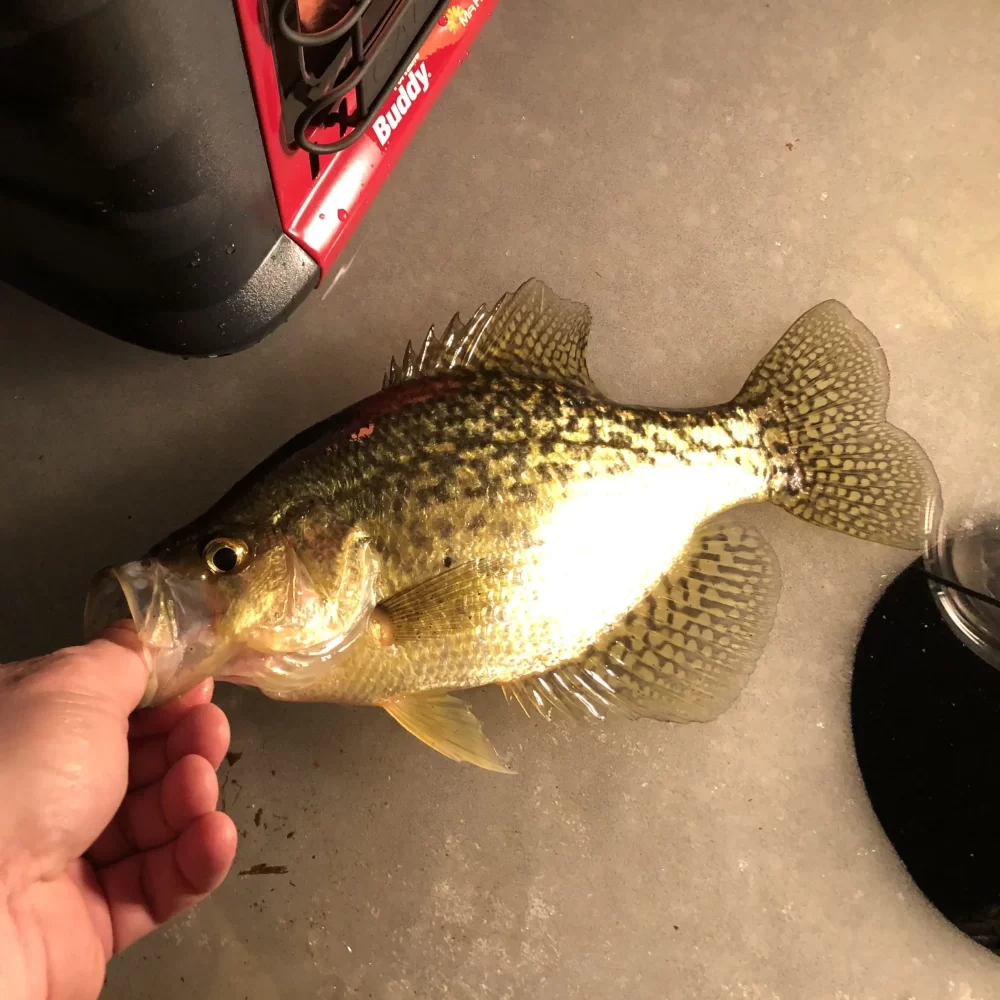
* This page contains affiliate links. The Great Lakes Fisherman may earn a commission on items purchased through these links. For more on this, please click here.
One of the most popular fish species to target through the ice is crappies. They also happen to the be a favorite of The Great Lakes Fisherman. While these tasty fish can be caught throughout the day on most lakes in the Great Lakes region, crappie are a low-light fish. This means that the best times of day to target them, especially in clear water, are in the early morning and late evening hours. In fact, one the most productive times of day for catching crappie is just before sunset to several hours after dark. But ironically, just when the crappie are starting to bite, most fisherman are heading to the car. With a little preparation and the right equipment, however, fishing into the night can be one the most rewarding experiences on the ice. If you’re new to this type of fishing and don’t know where to start, read on! The following info will help get you onto the fish fast.
Safety First
The first thing to consider when ice fishing after dark is safety. Being alone by yourself after dark can be dangerous. Always take a friend along to make sure you have help in the case of an emergency. The last thing you want is to get into trouble while you are alone out on a lake in the dark with no one around to help.
As always, follow all general ice fishing safety tips. You can find some great ice fishing tips in this article. To that end, be sure to arrive well before dark to ensure that the ice conditions are safe. This way, you can get to your spot, get setup and have time to check out the surroundings to be sure there are no obvious dangers before you lose daylight.
Finally, remember that there is always risk associated with ice fishing. When in doubt, don’t go out. Live to fish another day!
Equipment Needed
Aside from all of your standard ice fishing equipment (rod, reel, bait, auger, etc.), there are a couple of things you will need to make your night trip a success.
First off, you will need a strong light source. There are a couple of main options that you have for this, the first of which is a lantern. These come in both gas and electric varieties.
When it comes to gas lanterns, Coleman makes a dual fuel gas lantern as well as a propane lantern. Either of these are great options and will do the trick. One of the advantages of a gas lantern are that they also supply a source of heat to keep your hands warm.
The second main option for a light source is a submersible light Be sure to check your local regulations to be sure that they are legal in your jurisdiction.
Regardless of which light source you choose, the main thing is you need something that will penetrate the water column. The deeper the water you are fishing, the stronger the light you will need.
The second thing that you should have is a sonar flasher unit. Although not required, this is highly recommended as it greatly increases your catch rate, especially on the ice. For one, it lets you know if there are any fish under you. This is particularly important for ice fisherman because you are forced to fish from a single spot and lack the mobility of open water fishing. Second, it let’s you know where in the water column the fish are located. When fishing for species that tend to reside close to the bottom, this isn’t as critical because you can always find the bottom. Crappie, however, can be found throughout the water column. Without knowing specifically where they are, you can fish all night right, right over fish without a bite because you have your bait at the wrong depth. Third, it provides real time feedback on how the fish are reacting to your presentation. There is no single piece of fishing equipment that has improved my catch rates more so than a sonar flasher for ice fishing.
Calling in the Fish
Fishing under a light at night is the key to attracting crappies. Why? Because you are effectively building a food chain right under your feet! Here’s how.
Stage 1: Getting a Light Cone Established
The first stage in the process is getting the light cone in place. It doesn’t hurt to get your light going once it starts to get noticeably darker. It takes some time for the light to start working, so if you wait until dark, you may be waiting longer into the night before the bite really gets going.
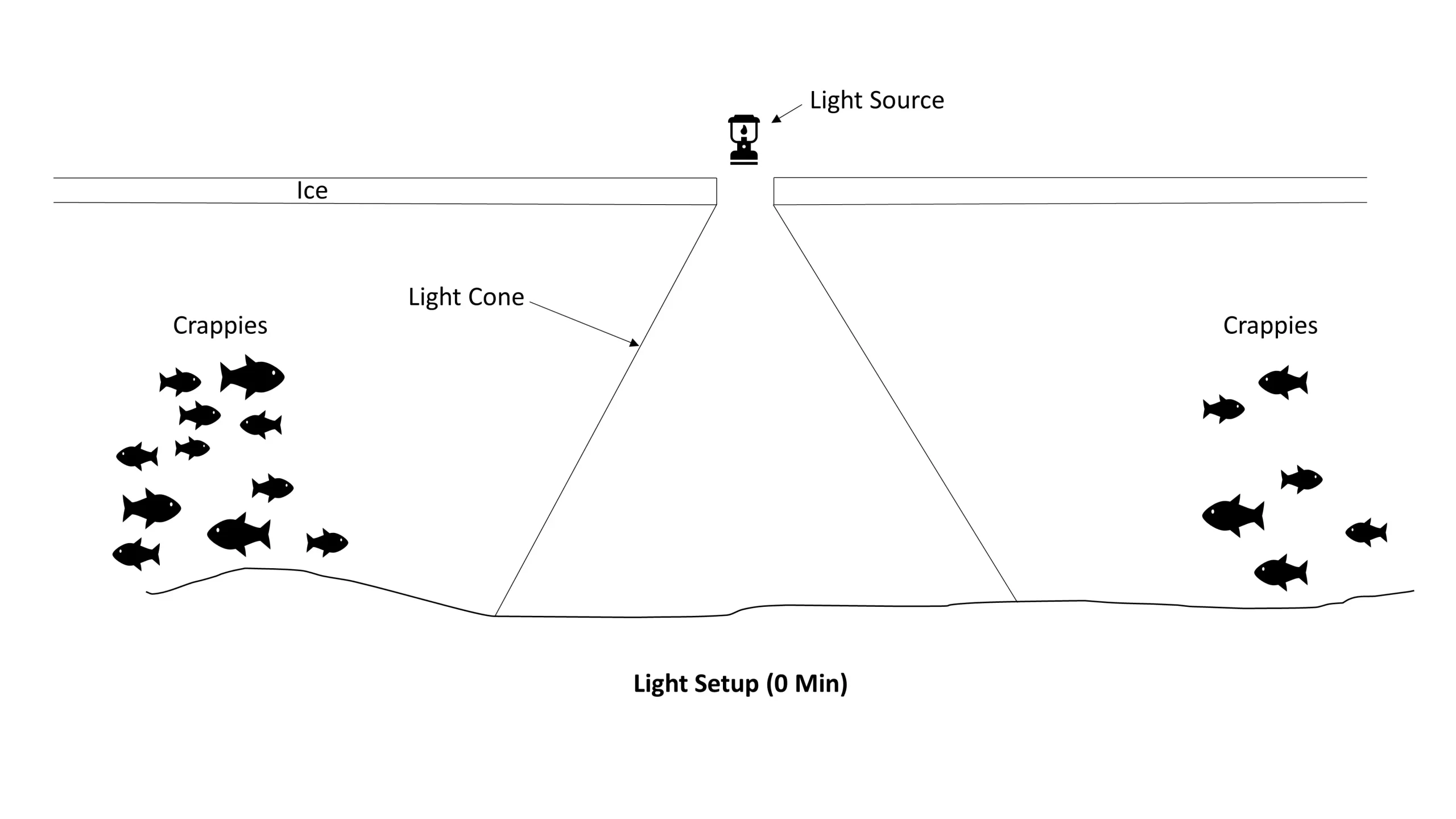
Stage 2: Plankton Show Up
As the light in this cone becomes brighter than the ambient light under the water, it will begin to attract plankton. These organisms provide food for minnows and other small fish.
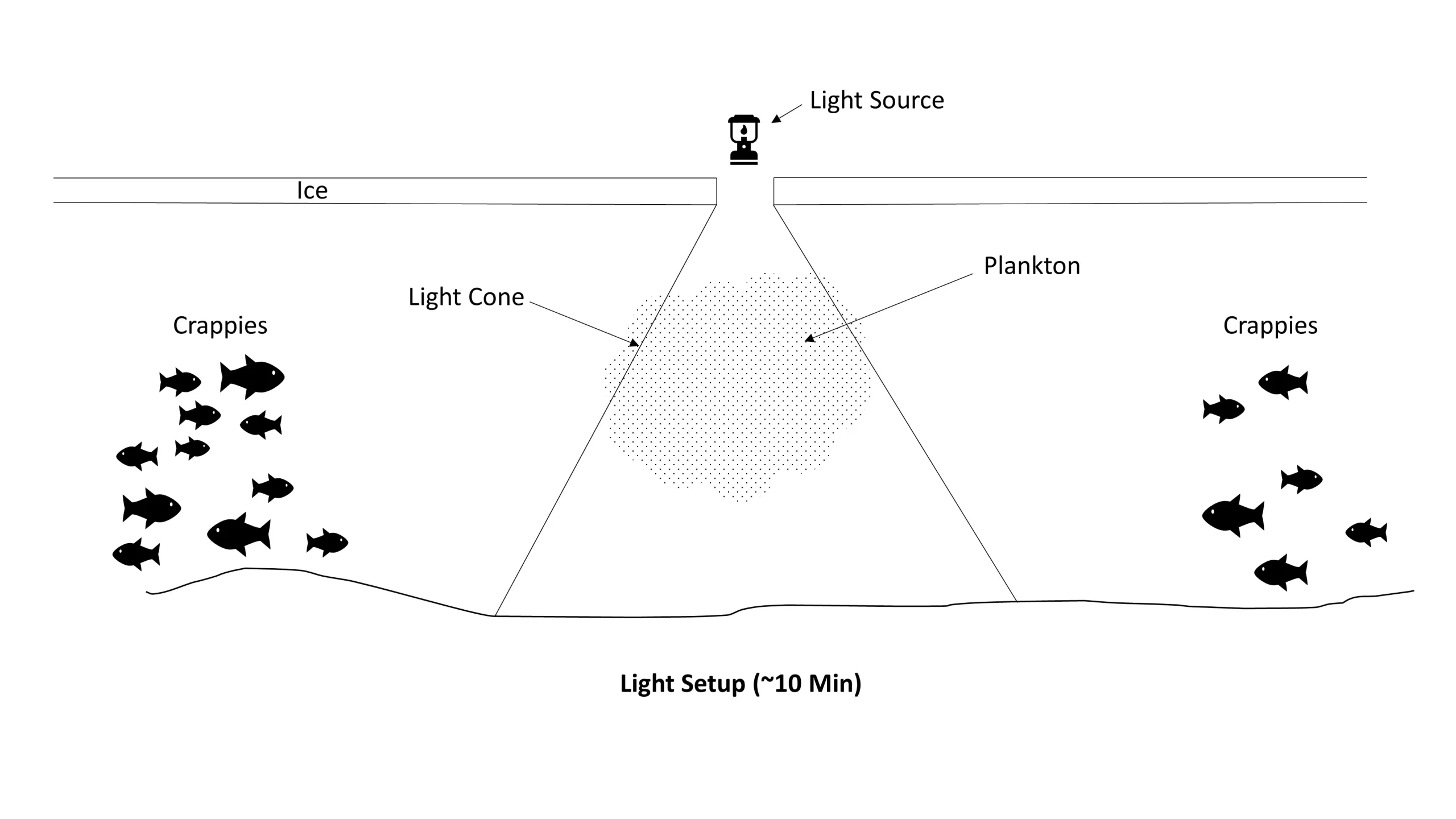
Stage 3: Minnows Show Up
Once the plankton cloud has established itself in the light cone, minnows will begin to show up to take advantage of the concentrated food source.
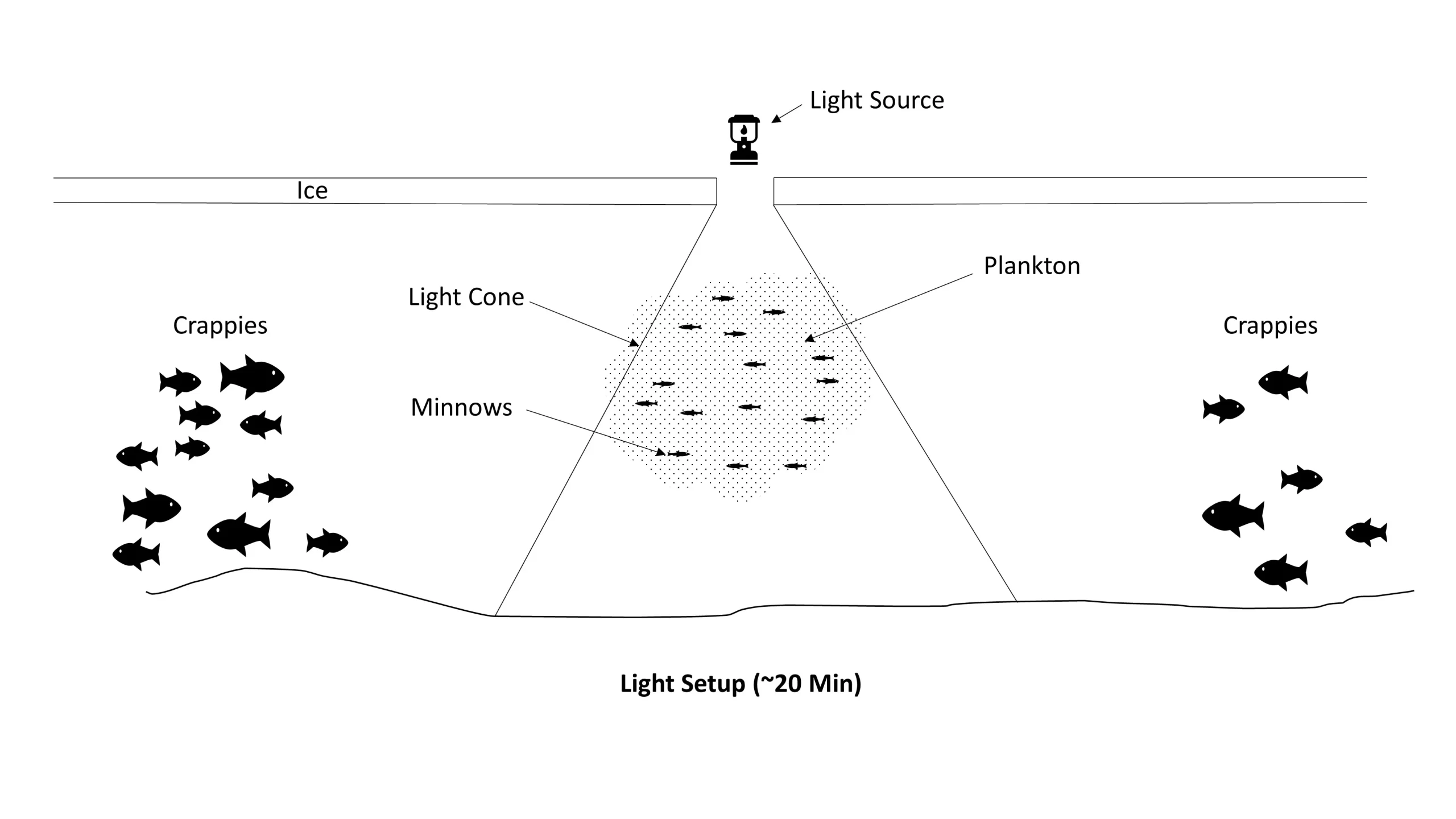
Stage 4: Crappies Show Up
Finally, crappie and other gamefish show up to begin feasting on the minnows. Now it’s time to catch some slabs!
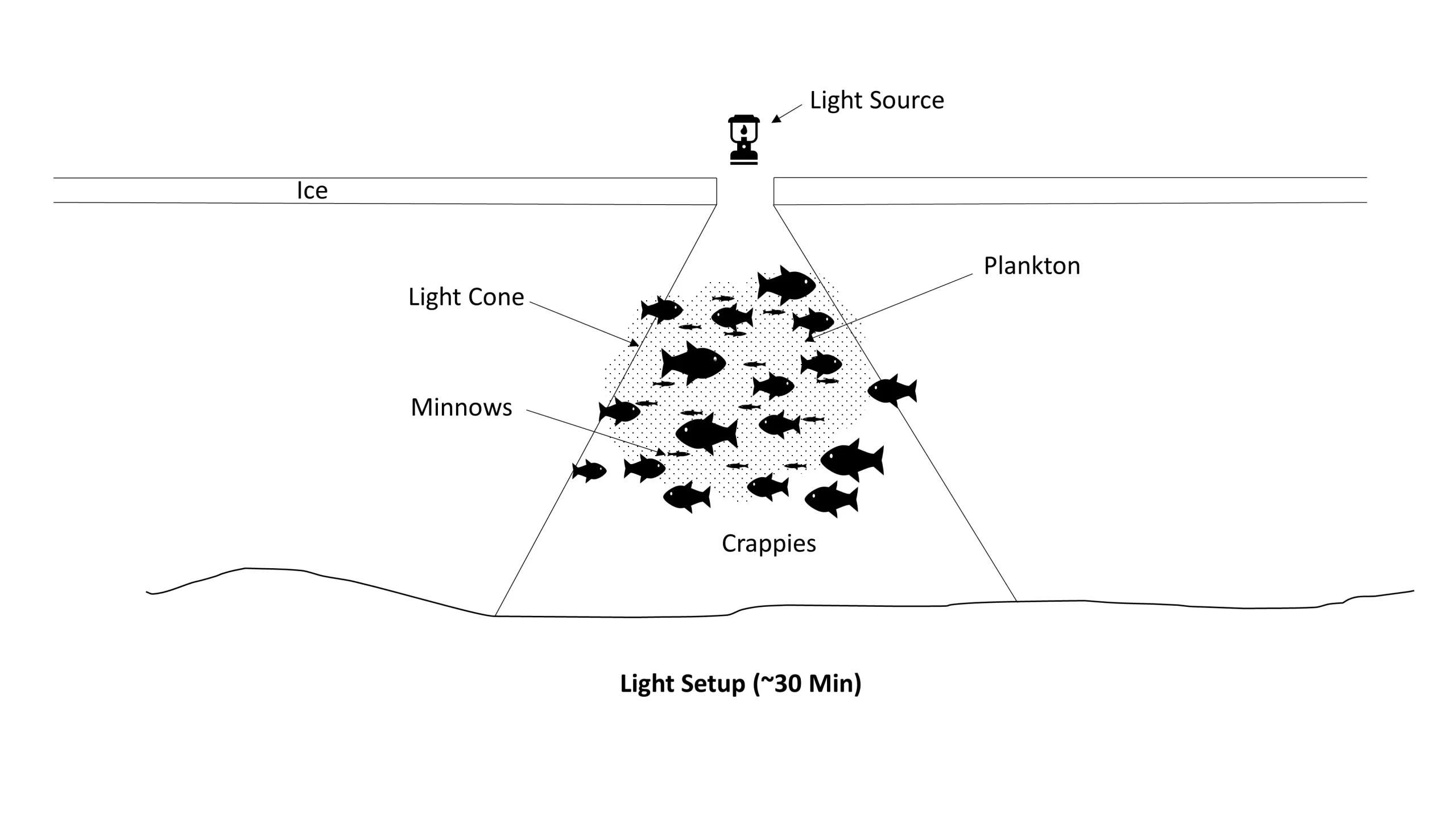
This technique is very productive as long as you are in the general area where crappies are known to inhabit. If after 30 minutes in one location there are no signs of fish, it’s probably time to move.
Catching Crappie
Now that the fish are here, it’s time to catch them. But how?
Crappie are built to hunt for prey above them. If you don’t believe it, just take a look at a crappie from the top. You will notice that both eyes are clearly visible, which means that both eyes can easily see anything that moves above them. With the lantern light providing a bright backdrop, the plankton and minnows are easy to see, making feeding easy.
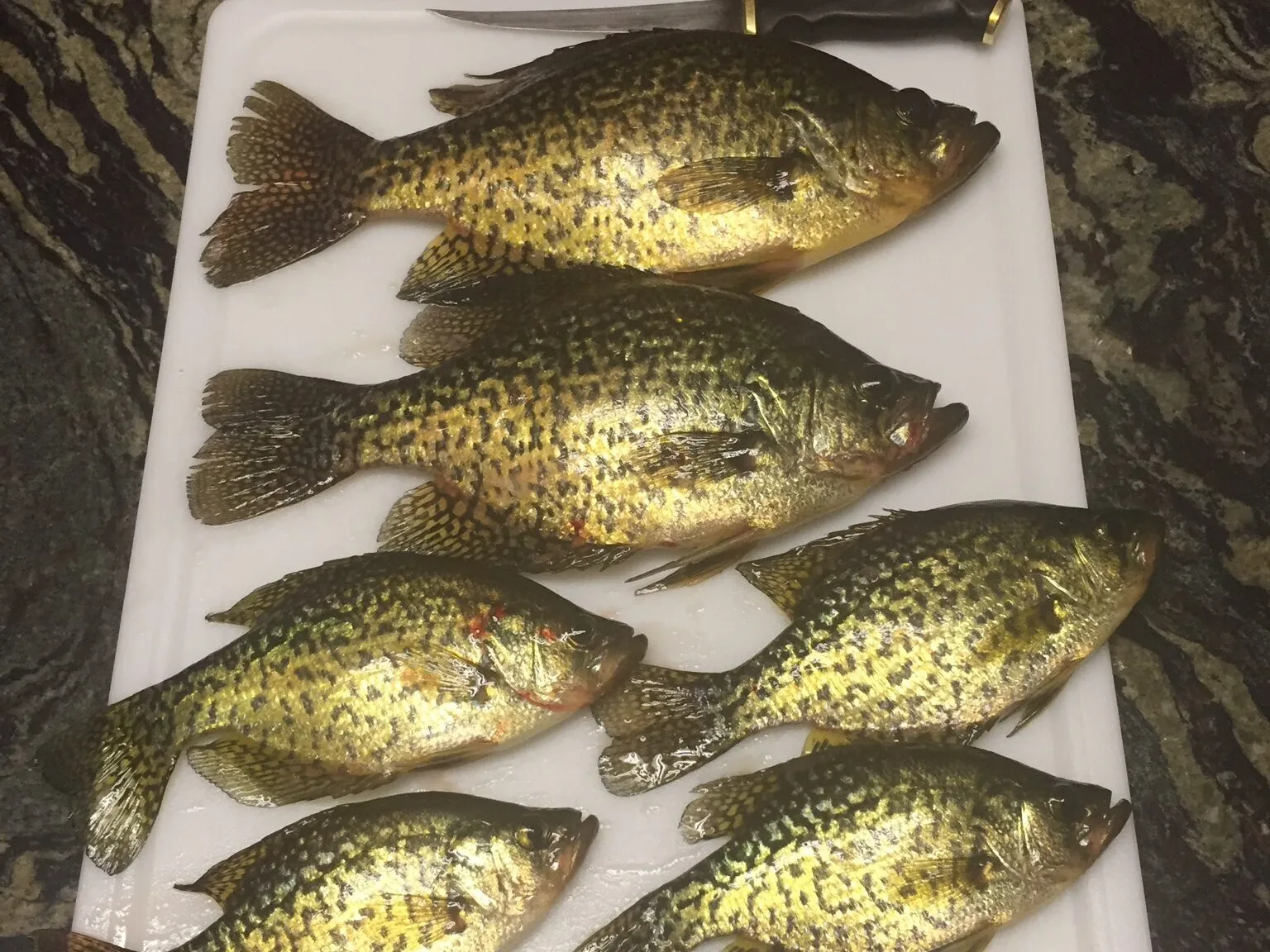
When targeting these fish, a common technique is to slowly lift your bait (usually a minnow or grub-tipped jig) using a slight jigging action. This will trigger a strike much faster than any other technique. If you are using a flasher (sonar) unit, start your bait at or just below the fish you are targeting and, using a jigging motion, bring your bait up slowly. You may notice the fish starting to follow the bait once it gets a foot or so above them. If they start to chase aggressively, a common technique is to abruptly stop the jig. This will result in the crappie sort of “running into the bait” unexpectedly which often times will elicit a strike. Just keep repeating this pattern on different targets. You may find fish at certain depths are more active than fish at other depths.
Night time fishing for crappies is one of the most productive ways I have found to catch these fish in the north. With a little experimentation, you will find the baits, colors and techniques to fill your bucket in no time. If you have any questions or are still struggling to find and catch crappies using the information in this article, feel free to drop me a comment below or send an email and I’d be happy to help provide some advice!
Stay safe out there!

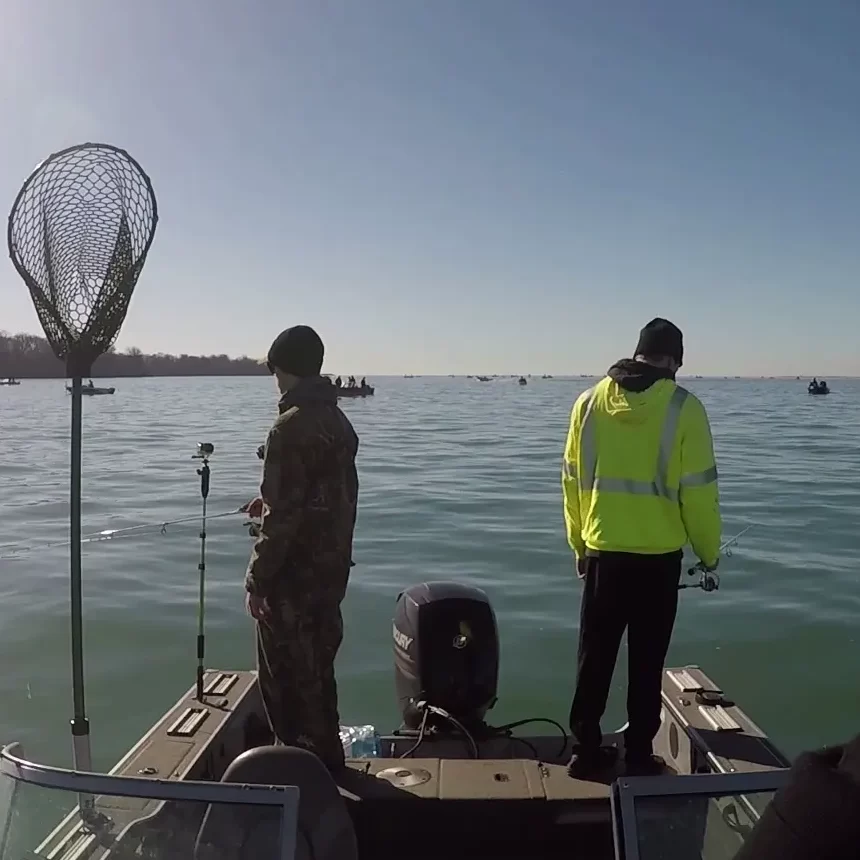


))/3775968.json)
))/2703975.json)
